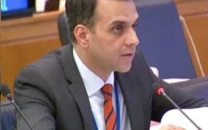Afghan peace deal — Taliban’s perspective
The hiccup in the peace process by Trump raises an ugly question: a lack of sincerity on part of the US administration

The writer is a retired Major General interested in International Relations and Political Sociology. He can be reached at tayyarinam@hotmail.com
The Taliban rightfully shared the sanguinity about the outcome of the ninth round of the Doha talks and were fairly optimistic — as far as their leadership of the Doha office was concerned — about concluding a deal on their terms through the efforts of a one-time Afghan, the maverick, Zalmay Khalilzad. The process did not fail owing to the killing of a US soldier in Kabul on September 5 — as was the impression generated by President Trump in his tweets — since violence was never an impediment to the talks on either side. Mike Pompeo himself proudly announced the killing of more than 1,000 Taliban fighters in the 10 days before the deal’s cancellation in incessant operations by the US, that continue.
From a distance, the US President abandoned an agreed framework, wherein the Taliban perceptibly conceded very little on their key demands. It appears that adjustments and compromises were made on major issues like a permanent ceasefire, withdrawal timeline of the occupation forces, intra-Afghan dialogue and the Taliban commitment to not allow transnational groups like Al Qaeda, etc to use Afghan soil for attacks against the US.
From the Taliban perspective, the core point during the course of negotiations remained the linkage of a ceasefire with foreign troop withdrawal. As per the Taliban’s reckoning, ceasefire and withdrawal had to go hand in hand, duly synchronised. We will come back to the issue of a complete withdrawal of foreign forces — as demanded by the Taliban or partial withdrawal — as affirmed by the US, later. Both sides had agreed on a phased withdrawal spanning 15-16 months with over 5,000 US troops leaving in four and a half months. President Trump, in a Fox News interview on August 29, spoke about reducing US military strength from the current 14,000 to 8,600 personnel. However, he did mention leaving behind US military, including intelligence personnel on permanent bases. While the Taliban could have been amenable to a phased withdrawal, under their strategy of “fight and talk”; permanent basing of US military is an anathema to the Taliban rank and file.
The Taliban understand that the US pullout should not be hastened, and must be measured and phased in order to optimally fill the security vacuum left behind and avoid the rise of local warlords and strongmen. However, the occupation forces had to leave completely at the end of the agreed timeframe. Suggestions like the one initiated and supported by some administration officials, despite opposition by Gina Haspel, the CIA Director, to leave a patchwork of CIA supported local militias (called Orbaki) to deal with threats and ensure residual US and Afghan government leverage did not sit well with the Taliban. The CIA’s shadowy paramilitary arm, the Ground Branch, raised the Orbaki forces during the 2001 invasion and they continue as a permanent fixture of the Afghan security apparatus outside the Afghan government.
The curtailed permanent presence of the foreign forces has two implications from the Taliban standpoint. First, the Taliban understand the global relevance tied to the US presence, hence the continued international financial support for subsequent rebuilding, reconstruction and development of Afghanistan. The country remains heavily dependent upon foreign financial assistance particularly since 2001. Second, for the above-perceived gains and fitting into the Taliban take-over strategy, they, therefore, seem to have agreed to a “scheduled” US presence. This timed presence was camouflaged in the phased withdrawal, hence the 16-month timeline. Even this is ostensibly very hard sell to the Taliban in the field fighting to oust all foreign forces as soon as possible.
Likewise, a complete ceasefire is against the raison d’être of the Taliban movement, as reasoned consistently, for its potential to demobilise and splinter the movement — hence the continuation of the “fight and talk” strategy. However, a “partial ceasefire in terms of time or area of the contest” to allow the occupation forces to pullout — fulfilling the conditions of the agreement — is considered an agreed alternative by the Taliban.
It was in the subsequent intra-Afghan dialogue under the aegis of the Norwegian government scheduled on September 23, 2019 — once the agreement was signed — that issues like bringing down the level of violence between the contenders were to be ironed out. Until now the Taliban maintain their principal stance of not talking to the “puppet regime” of Ashraf Ghani.
So any compromise or perception thereof, on the central issues of “no ceasefire, complete withdrawal and illegitimacy of the Afghan government” was deemed to cause a loss of credibility for the Taliban leaders in Doha. Reportedly, Qatar was using its considerable financial clout to nudge the situation. However, sceptics believe that even if all the cited differences were sorted out and the agreement signed; there would still be obstacles like settlements on the nitty-gritty and their subsequent implementation due to the huge trust gap among the parties.
The breakdown in the peace process by President Trump has raised many ugly questions like the lack of sincerity on part of the US administration; using the negotiations to make inroads into the movement and divide it; the US intentionally wanting to keep the pot-boiling; the Indian involvement and behind the door efforts in collusion with the Afghan government to scuttle the process, etc.
Nevertheless — paraphrasing the Taliban — the conflict can end on the negotiation table or on the battlefield. The US has to choose. So far the battlefield seems to have been chosen. In response, the Taliban are also on the offensive with a renewed vengeance and violence. Their operations continue unabated across Afghanistan in areas like Kabul, Balkh, Kunduz, Parwan, Farah, Faryab, Logar, Takhar, Puli Khumri, Wardak, Maiwand, Uruzgan, Arghandab, Qalat and Kandahar, etc.
Crystal-gazing Afghanistan, one is reminded of a Pashto proverb, “khabarey pe khabaro khlasigee” (issues are resolved through talks). Both sides will have to resume negotiations, sooner than later. A deal, however imperfect, is better than the status quo; otherwise, the Afghan quagmire can impose a “no-deal exit”. Stopping the peace process, even as a “negotiation tactic”, will cost many more lives. Someone, someday, somewhere will have to pay the price.
Published in The Express Tribune, September 24th, 2019.
Like Opinion & Editorial on Facebook, follow @ETOpEd on Twitter to receive all updates on all our daily pieces.



















COMMENTS
Comments are moderated and generally will be posted if they are on-topic and not abusive.
For more information, please see our Comments FAQ